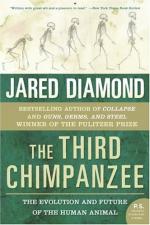
|
| Name: _________________________ | Period: ___________________ |
This test consists of 15 multiple choice questions and 5 short answer questions.
Multiple Choice Questions
1. With what does the chapter conclude?
(a) An ethical discussion about the implications of classifying chimps as Homo.
(b) A discussion about the similarities between humans and chimps.
(c) Why chimps should not be classified as Homo.
(d) The differences between humans and chimps.
2. Can natural selection explain these traits?
(a) Frequently.
(b) Sometimes.
(c) Yes.
(d) No.
3. To what is the pair bonding found among humans probably due?
(a) The inordinately high burden of childcare found within human societies.
(b) The difficulty of surviving on one's own.
(c) The need for a permanent mate.
(d) The need for having many children.
4. What is a fundamental aspect of humanity and in general is easy to determine even by non-experts?
(a) Intelligence.
(b) Race.
(c) Religion.
(d) Country of origin.
5. What does evidence suggest about how long race has been a characteristic of modern humans?
(a) A somewhat short time.
(b) A somewhat long time.
(c) A very short time.
(d) A very long time.
6. When do chimps, humans, and gorillas break off from the remaining higher primates?
(a) C. 20 millions of years ago.
(b) C. 15 millions of years ago.
(c) C. 5 millions of years ago.
(d) C. 10 millions of years ago.
7. What has been learned about this species?
(a) They use at least fifteen distinct sounds to convey specific meanings.
(b) They use at least twenty distinct sounds to convey specific meanings.
(c) They use at least five distinct sounds to convey specific meanings.
(d) They use at least ten distinct sounds to convey specific meanings.
8. The human penis is largely used for what?
(a) Male-male display.
(b) Male-female display.
(c) A higher frequency of sexual activity.
(d) Attracting the female.
9. Why does the author largely reject this belief?
(a) Many animals are capable of learning new information.
(b) Many animals have the capabilities to love.
(c) Many animals and most mammals use vocalizations; clearly, they convey some sense of meaning.
(d) Many animals understand each other and other species.
10. What strongly reinforces the desire for racially distinct partners?
(a) Education.
(b) Childhood imprinting.
(c) Infant imprinting.
(d) Genetics.
11. What is considered by most scientists to be uniquely human?
(a) Language.
(b) Learning.
(c) Love.
(d) Understanding.
12. What other creatures practice a form of agriculture?
(a) Mice.
(b) Ants.
(c) Dogs.
(d) Fleas.
13. What theory does Darwin offer to explain these traits?
(a) The theory of sexual selection.
(b) The theory of physical selection.
(c) The theory of genetic selection.
(d) The theory of natural selection.
14. To what did agriculture give rise?
(a) Organizations.
(b) Social settings.
(c) Technology.
(d) Class divisions.
15. Does penis size correspond to frequency of sexual intercourse?
(a) Yes.
(b) In some species.
(c) Sometimes.
(d) No.
Short Answer Questions
1. Do all animals that show artistic tendencies satisfy each criterion?
2. How selective are humans across an array of traits?
3. When did a great division in the human lineage occur?
4. About 200,000 years ago, H. sapiens appears to have diverged into two distinct lineages usually known as what?
5. What sexual strategy does the author say individual humans should adopt?
|
This section contains 513 words (approx. 2 pages at 300 words per page) |

|




